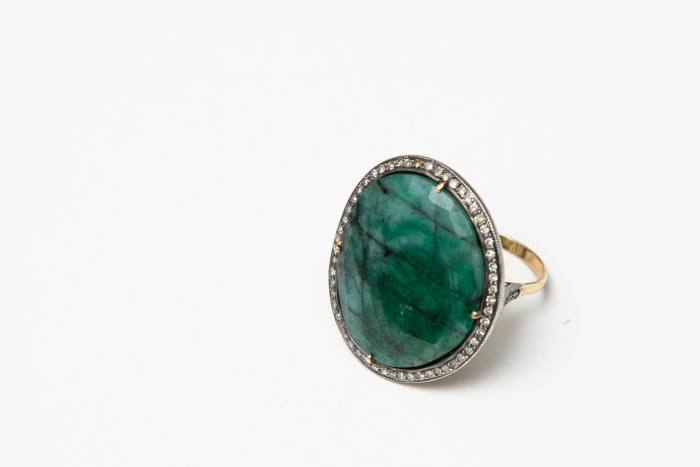Growing up in India, interior designer Charu Gandhi learnt to appreciate jewellery as something meaningful through family stories. Her grandparents left what is now Pakistan during partition in 1947 with only a couple of trunks of belongings. “I come from a family that had a lot of land, these beautiful homes . . . but all that’s really left of that legacy is the jewellery,” says Gandhi, founder of the London design studio Elicyon.
Most of her collection is inherited traditional Indian pieces but she has also bought contemporary jewellery during visits to the annual Goldsmiths’ Fair in London, with her silversmith mother, Manju.
Gandhi was part of the judging panel that selected the 136 jewellers and silversmiths exhibiting at this year’s fair, which runs from September 27-October 9, and says the experience taught her much about provenance that will inform her future collecting.
“There were some pieces that maybe, at surface, I wouldn’t have apportioned much value to but other jurors talked about the specifics of the making,” she says. “Whereas there were pieces that were very striking, but the panel talked about . . . how there was a technique that had been used that actually wasn’t that much associated with handicraft.”
Barbara Christie brooch (c2008)

This silver brooch with gold etching was one of her early Goldsmiths’ Fair purchases with her mother. Christie taught Gandhi’s mother jewellery design at Central Saint Martins, an art school in London.
“[The brooch] was the beginning of a shift for me — from buying jewellery that was always gem based, quite elaborate and high value, to buying something very architectural, quite simple, but made by someone we would call a master silversmith and appreciating it for its making, simplicity and purity of form,” says Gandhi.
Brooches were not something she wore growing up in Asia — she lived in Delhi and went to boarding school in Singapore — so she regards them as a symbol of the “anglicised side” of her life.
Manju Gandhi kinetic piece (2003-04)

Gandhi moved to the UK to study at the Architectural Association School of Architecture in London, in 1997. This silver brooch with tourmalines, made by her mother, reminds Gandhi of the drawings she did when writing a software programme — inspired by nature and the multiplication of cells — as part of her course.
Gandhi wore the piece, which has moving parts and can be worn on a string on the neck, at her graduation in 2004.
Her mother, who began studying jewellery design when Gandhi was a child, does not sell her work.
“I’ve enjoyed watching her progression, knowing the effort and care that she puts into making these pieces and how much they mean to her,” she says. “Beyond me and my brother, they are her babies.”
Grima earrings (2018)

Gandhi describes her own and her mother’s jewellery as a “shared pot”. She found it “very empowering” to be able to buy these yellow gold and diamond earrings at the Masterpiece London art fair.
Jewellery made by Grima, the brand founded by the modernist designer Andrew Grima, had long held an “unattainable quality” for Gandhi. “It was something you saw, you looked at but you were never going to own,” she says.
However, after her company had a very good year, she could afford to buy the earrings, to wear to her brother’s wedding in Sri Lanka, in 2019.
Turkish Victorian necklace (19th century)

For her own wedding in 2016, Gandhi wore this gold, diamond and emerald necklace gifted by her friend, the potter Diana Peyton.
She had helped Gandhi get her first job and taught her about British and London life. “There is family and then there are people who come into your life who make you their family,” says Gandhi.
She says Peyton had been given the necklace by her American husband, in Beirut, when she flew to meet him on a whim before they were married.
Vintage emerald ring (date unknown)

The proposal that led to Gandhi’s marriage followed a first attempt that went slightly wrong, on a holiday in Megève, in 2015.
Gandhi told her boyfriend, Jarek, that one of her colleagues had been proposed to with a temporary engagement ring, so that the actual ring could be a design of her colleague’s own choosing. When, later that same day, Gandhi spotted a vintage emerald ring in a shop, her boyfriend asked if she would like it as a temporary engagement ring.
But he then said he wanted to buy it as a birthday present instead.
“He realised that I had said I would really love if he asked my dad before he proposed,” Gandhi explains. “He basically panicked and realised that he hadn’t done that, and so that’s why it came across like he’d changed his mind!”
At the time, Gandhi was so annoyed that she bought the ring herself and her boyfriend transferred her the money. A week later, he asked her father’s permission and proposed a few weeks after that — with another temporary ring.
Gandhi loves sharing this tale. And, in so doing, she is continuing the storytelling around jewellery with which she grew up.
Stay connected with us on social media platform for instant update click here to join our Twitter, & Facebook
We are now on Telegram. Click here to join our channel (@TechiUpdate) and stay updated with the latest Technology headlines.
For all the latest Fashion News Click Here
